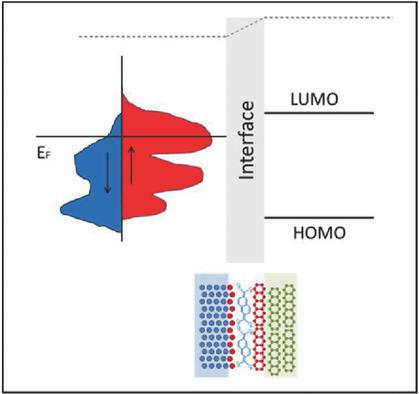当前位置:
X-MOL 学术
›
Adv. Electron. Mater.
›
论文详情
Our official English website, www.x-mol.net, welcomes your feedback! (Note: you will need to create a separate account there.)
11,11,12,12‐Tetracyanonaphtho‐2,6‐quinodimethane in Contact with Ferromagnetic Electrodes for Organic Spintronics
Advanced Electronic Materials ( IF 6.2 ) Pub Date : 2018-05-31 , DOI: 10.1002/aelm.201800077 Shengwei Shi 1, 2 , Zhengyi Sun 3 , Xianjie Liu 2 , Amilcar Bedoya-Pinto 4 , Patrizio Graziosi 5 , Huangzhong Yu 6 , Wenting Li 1 , Gang Liu 1 , Luis Hueso 4 , Valentin A. Dediu 5 , Mats Fahlman 2
Advanced Electronic Materials ( IF 6.2 ) Pub Date : 2018-05-31 , DOI: 10.1002/aelm.201800077 Shengwei Shi 1, 2 , Zhengyi Sun 3 , Xianjie Liu 2 , Amilcar Bedoya-Pinto 4 , Patrizio Graziosi 5 , Huangzhong Yu 6 , Wenting Li 1 , Gang Liu 1 , Luis Hueso 4 , Valentin A. Dediu 5 , Mats Fahlman 2
Affiliation

|
Spinterface engineering has shown quite important roles in organic spintronics as it can improve spin injection or extraction. In this study, 11,11,12,12‐tetracyanonaptho‐2,6‐quinodimethane (TNAP) is introduced as an interfacial layer for a prototype interface of Fe/TNAP. An element‐specific investigation of the electronic and magnetic structures of Fe/TNAP system by use of near edge X‐Ray absorption fine structure (NEXAFS) and X‐ray magnetic circular dichroism (XMCD) is reported. Strong hybridization between TNAP and Fe and induced magnetization of N atoms in TNAP molecule are observed. XMCD sum rule analysis demonstrates that the adsorption of TNAP reduces the spin moment of Fe by 12%. In addition, induced magnetization in N K‐edge of TNAP is also found with other commonly used ferromagnets in organic spintronics, such as La0.7Sr0.3MnO3 and permalloy, which makes TNAP a very promising molecule for spinterface engineering in organic spintronics.
中文翻译:

与用于有机自旋电子学的铁磁电极接触的11,11,12,12-四氰基萘-2-6,喹啉二甲烷
Spinterface工程在有机自旋电子学中已显示出非常重要的作用,因为它可以改善自旋注入或萃取。在这项研究中,引入11,11,12,12-四氰基萘-2,6-喹二甲烷(TNAP)作为Fe / TNAP原型界面的界面层。报告了通过使用近边缘X射线吸收精细结构(NEXAFS)和X射线磁圆二向色性(XMCD)对Fe / TNAP系统的电子和磁性结构进行的元素特定研究。观察到TNAP和Fe之间的强杂交以及TNAP分子中N原子的磁化。XMCD和规则分析表明,TNAP的吸附使Fe的自旋矩降低了12%。此外,还发现有机自旋电子学中的其他常用铁磁体(例如La)也能在TNAP的NK边缘中感应出磁化强度。0.7 Sr 0.3 MnO 3和坡莫合金,这使得TNAP成为有机自旋电子学中界面工程非常有前景的分子。
更新日期:2018-05-31
中文翻译:

与用于有机自旋电子学的铁磁电极接触的11,11,12,12-四氰基萘-2-6,喹啉二甲烷
Spinterface工程在有机自旋电子学中已显示出非常重要的作用,因为它可以改善自旋注入或萃取。在这项研究中,引入11,11,12,12-四氰基萘-2,6-喹二甲烷(TNAP)作为Fe / TNAP原型界面的界面层。报告了通过使用近边缘X射线吸收精细结构(NEXAFS)和X射线磁圆二向色性(XMCD)对Fe / TNAP系统的电子和磁性结构进行的元素特定研究。观察到TNAP和Fe之间的强杂交以及TNAP分子中N原子的磁化。XMCD和规则分析表明,TNAP的吸附使Fe的自旋矩降低了12%。此外,还发现有机自旋电子学中的其他常用铁磁体(例如La)也能在TNAP的NK边缘中感应出磁化强度。0.7 Sr 0.3 MnO 3和坡莫合金,这使得TNAP成为有机自旋电子学中界面工程非常有前景的分子。



























 京公网安备 11010802027423号
京公网安备 11010802027423号